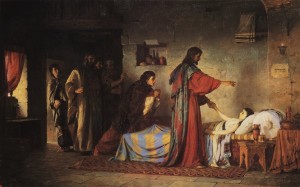Continuing with our series on gospel “contradictions,” today we look at the account of Jairus’ daughter. Jairus was a Jewish elder whose daughter became very ill and died. Immediately, Jairus asked Jesus if he could heal her. According to both gospel accounts, Jesus raised Jairus’ daughter back to life. However, critics point out an apparent contradiction between the accounts in Mark and Matthew. This alleged contradiction is extremely minor, but it seems to be important to some people. So, here goes…
The Alleged Contradiction
First up is the relevant passage in Mark 5:22-23 (ESV):
22 Then came one of the rulers of the synagogue, Jairus by name, and seeing him, he fell at his feet 23 and implored him earnestly, saying, “My little daughter is at the point of death. Come and lay your hands on her, so that she may be made well and live.”
Now, let’s read Matthew 9:18 (ESV):
18 While he was saying these things to them, behold, a ruler came in and knelt before him, saying, “My daughter has just died, but come and lay your hand on her, and she will live.”
There’s a subtle difference in the introductory passages above. In Mark’s account, Jairus says his daughter is “at the point of death” while in Matthew’s account, he is depicted as saying that his daughter has already died. It’s important to note that in both accounts, the girl is dead by the time Jesus gets to her, so they are consistent on that point. The difference hinges on what Jairus said. Did he say she was already dead or didn’t he?
Most people would look at the passages above, shrug, and say, “They’re independent accounts, so some little differences in detail are to be expected. Who cares?” Unfortunately, atheist authors and scholars continue to point to these passages as evidence that the gospels are unreliable. So, let’s deal with it.
The Answers
There are several possible answers to this one. First, Matthew’s account is shorter and simpler than Mark’s. It’s entirely possible that Matthew compressed the story, simplifying it—in part—by presenting that the girl had died up front. In the gospels, we see this type of “compression,” in which minor details are eliminated or glossed over—or events that took place over a longer period of time are compressed into a shorter one—so as to more quickly tell the core story. This type of compression was a common literary device.1
Tim McGrew adds that, “according to several scholars (Stein, Blomberg, Witherington), such usage would be within the conventions of reportage of the time and would not have been considered to be an error by the standards of Matthew’s contemporaries.”2
Taking another tack, McGrew also says:
According to Chadwick, Matthew’s expression “has died even now” (ἄρτι ἐτελεύτησεν) is so close in meaning to Mark’s “at the point of death” (ἐσχάτως ἔχει) that a person full of anxiety might say “she is dead by now” and mean what we would express by saying “she is at the point of death.”3
If that’s the case, then there is no contradiction. The key point is: This alleged contradiction is probably not a contradiction, and even if it is, then so what? It relates to a minor detail, and is the type of difference one would expect to see when reviewing independent accounts of the same event. Critics who would make a big deal over this one probably just need to get out more.
Notes
- Michael Licona, “Fish Tales: Bart Ehrman’s Red Herrings and the Resurrection of Jesus”, Come Let Us Reason: New Essays in Christian Apologetics, Paul Copan and William Lane Craig, editors, B&H Publishing, Nashville, TN, 2012, p. 148
- Timothy McGrew, Alleged Contradictions in the Gospels, Part 2, 2012, presentation, slide 13, accessed on Jan. 17, 2016 at http://www.apologetics315.com/2012/09/alleged-contradictions-in-gospels-2-by.html
- Ibid, slide 14.

